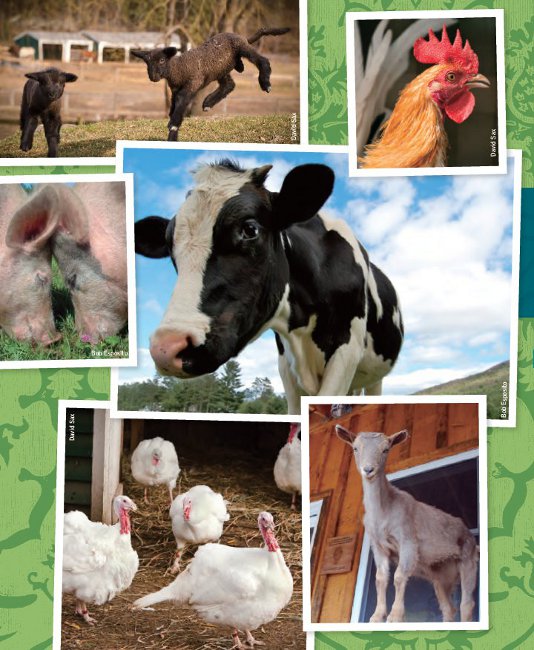
CHAPTER 4
TUSHIE &
MILK MUSTACHES
Are you ready for the Crazy Sexy Truth about meat and dairy? Of course you are! You’re a fearless Wellness Warrior full of rebellion and fire. So with that in mind, it’s party time and I’m gonna give you a big, phat prezzie. In fact, this treasure is so top-shelf that it’ll keep you young, cute, and alive! Going veg is one of the best decisions you can make for your health and the planet. Period. Your organs, blood, bones, teeth, and private parts will thank you. Private parts? Yes, sassy, I’m talking sex drive! There’s no better way to light the night than to eat right.
I meant it when I said in chapter 1 that any change in your diet is a good one—a change from the SAD to an increase of plant-based foods is something I’ll celebrate along with you. But I won’t lie: For optimal health we need to reduce or, better yet, dump animal products. We’re just consuming too much of the stuff and it’s making us sick. It’s that simple, kitten, and I’m going to try some tough, straight talk to help you to think of meat and dairy in a new way. This is the talk that I got that helped me change my life. Maybe it will help you too. If not, I still love you.
There’s a lot for you to digest in this chapter, and you should take some time (and enzymes) to do so. My goal isn’t to convert you to veganism or judge and criticize you if you eat meat. My goal is to share the tools, knowledge, and facts I’ve learned so that you can have the best day, week, month, life ever! If at the end of this chapter your eyes are more open and you make healthier, cleaner, and more conscious animal product choices, then I’ve done my job. The day we stop questioning is the day we stop learning. Question where your food comes from and you’ll be in much better shape. What matters most is your longevity, so take the best, leave the rest, and fasten your seat belt, doll!
If your meals consistently revolve around corpse multiple times daily, you might become one sooner than you planned. I imagine that this statement is quite unsettling for some—it sure was for me. I grew up across the street from a small, family-owned dairy farm. Shooting milk from the udder straight into my mouth was fun. Udders also made terrific weapons. Point, aim, squeeze, and if you got lucky you’d nail a passing farmhand. (I adored causing trouble. It wasn’t till I tried my first bit of Red Man chewing tobacco that those sneaky bastards got me back. “You can swallow it, tastes like candy.” After about thirty seconds I barfed on his boot and cried. Touché.)
At home our daily meals revolved around animal products, and the options were either decadent or gross. My fiery Colombian grandma was a very imaginative chef who loved buckets of butter, Julia Child, and anything she could flambé (that is, douse with booze and set on fire, including, on occasion, the curtains). On decadent days dinner would consist of coq au vin or curried chicken. On gross days we might get tongue, chipped beef on toast (which has an uncanny resemblance to vomit), and Spam cake sandwiches. What’s a Spam cake sandwich, you ask? Alternating layers of the mysterious meat and slices of white bread covered with cream cheese. Since presentation was everything, Grandma topped the Spam cake with colorful cream cheese flowers made with food dye and shot through a pastry-decorating bag. Sometimes the cakes would even have my name on them.
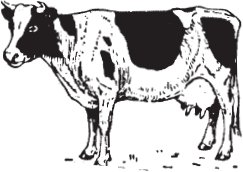
Grandma loved to experiment. The day my mom went into labor with me, she had just finished a big bowl of kidney stew with red wine glaze and scalloped potatoes. I imagine that the little me said, “Enough is enough, I’m outta here, lady!” My tastes, on the other hand, were simple. I could live happily on the following five foods in rotation: hamburgers, cereal, Ritz crackers with Cheez Whiz, PB&J, and fries.
When I was ten years old, I learned that there was a God, because she had finally answered my prayers by opening a Burger King on Route 22. I immediately begged Grandma to take me, but since fast food was foreign she vetoed the request in her thick Colombian accent. No (in any language) is not a word I stomach well—never have, never will. Though I didn’t have wheels, I still had my feet. So I pillaged her coat pockets and took off on a 10-mile walkabout. Boy, were those fries worth the hell I caught. In one fell swoop, I tasted freedom, independence, theft, and trans-fat-drenched carbohydrates. I was hooked. For the next two decades, fast food would be my rebellious comfort.
So I’m not just blowin’ smoke up your ass, I understand how hard it can be to change patterns. I found this amazing lifestyle because I was on the ropes. While I loved animals and nature, I didn’t make the connection. A burger has a face and is unhealthy? When we shake it up and wake it up, we realize that ignorance isn’t yummy or sexy or responsible.
Do you have to change everything all at once? No! As I said at the start, I don’t expect you to go full-tilt boogie. Even if you don’t eliminate flesh completely, cut way back—snip snip, trim trim. The American Dietetic Association recommends that meat, poultry, and fish portions should be no more than the size of a deck of playing cards—about 3 to 4 ounces. Even for Texans!
To help you avoid (or at least reduce) animal products, let me clarify what we’re talking about here. Meat = a being with ideas, a mother, family, and community. Dairy = liquid meat from the breast of an animal with ideas, a mother, family, and community. I know it seems pretty obvious, but I come across a lot of folks who need a little “what’s a sentient being” refresher because they’re under the false impression that chicken and fish don’t count.
The vast majority of our animal consumption comes from the famous five: cow, chicken, turkey, pig, fish. But there’s a whole Noah’s ark of notable noshables: lamb, goat, duck, bunnies, frogs, buffalo, deer, elk, ostrich, shellfish, snakes, eel, monkey, and for all you Deliverance guys still out there, squirrel. Basically, if it moves, we find ways to kill it and eat it. Then there’s milk. Cow, goat, and sheep are our main sources for cottage cheese, cream cheese, cheese, sour cream, butter, ice cream, yogurt. And what about eggs? Somewhere along the line we mistakenly grouped them with dairy (probably because they’re next to butter and cheese in the grocery store), but actually they are considered meat since they contain similar nutrients—and because they’re little chicken fetuses. So as you upgrade your diet, keep these critters and critter products in mind.
Here’s an easy way to reframe your plate. Think of meat and milk products as the supporting cast, grains as costars, and veggies as the center-stage divas. Animal products should be a side dish or treated as a condiment (if consumed at all), while plant-based foods make up the main course. This very simple and inexpensive change will rock your world, up your life span, and vanquish the scariest C of all—cellulite!
While we’re on the topic of thigh cheese, let’s dive into a vat of fat for a hot minute. Your body’s fat cells are all present by age ten for the most part, but the little buggers are very elastic and can grow in size at any point. A healthy vegetarian or vegan diet consumed in moderate portions helps prevent fat cells from ballooning in size. The recipe for success: Eat lots of high-fiber foods, as many as possible in the raw form, and limit animal products and processed junk. Cellulite is a different beast than overall body fat. As Jennifer Reilly, RD (www.BitchinDietitian.com) says, “You can be ‘skinny fat’ and still have cellulite! Cellulite is formed because of fluid retention and the accumulation of waste products and toxins in the body. The Standard American Diet is very pro-cellulite! Breaking down these foods results in a ton of toxic waste products floating around our systems, and they are visible from the outside in the form of nasty cellulite.”
So are you panicked and wondering: “But what about protein? And where will I get my calcium?” Relax and release the fear. The truth is that we can get all the protein and calcium we need from a varied plant-based diet. The healthiest people on the planet are those who eat the fewest animal products. It takes a sexy revolutionary like yourself to buck the system and go your own way. And I promise you, it’s worth it. Eat clean and green and toast to life. Cheers!
PREVENTING THE BIG THREE with

A HEALTHY HEART
Neal D. Barnard, MD, best-selling author of Food for Life, Dr. Neal Barnard’s Program for Reversing Diabetes, and other titles, is the founder of Physicians Committee for Responsible Medicine (PCRM), a group that promotes preventive medicine and addresses controversies in modern medicine.
OMNIVORE OR HERBIVORE?
“But wait!” you say. “We’ve been eating body parts for ages, what’s the problem?” True. While our ancestors have been eating meat since they came down from the trees, they consumed it infrequently and in smaller portions. Also, the meat was very different. It was wild and fresh, not from diseaseridden factory farms that dose already sick animals with drugs and chemicals. Though we were huntergatherers, we gathered a heck of a lot more than we hunted. Woolly mammoth was a luxury saved for special occasions, like bar mitzvahs and weddings.
Many nutrition experts believe that humans are ill equipped to fully digest and absorb meat. Though we’re practicing omnivores, we appear to be more like herbivores physiologically. The true question: What’s optimal? The true answer: Plants.
Consider a carnivore, the lovely lioness. She has claws, fangs, and an abundance of hydrochloric acid to do the tough job of digesting flesh. I don’t know about you, but I’m not gonna chip my manicure attacking and gutting Bessie the cow. Humans have molars and masticating jaws, perfect for grinding and chewing high-fiber goodies. Our stomachs contain hydrochloric acid in smaller amounts better designed to digest plant proteins.
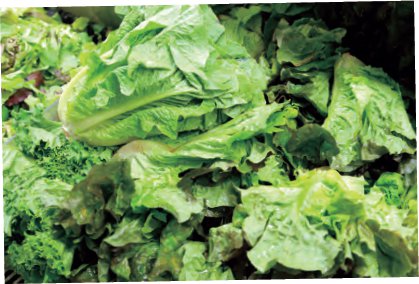
In addition, the lioness dines on fresh kill, preferably organs high in minerals. Because she doesn’t haul around a camping stove, Madame Lioness eats her food raw and therefore receives all the enzymatic benefits. Her short digestive tract ensures that zebra goes in, zebra comes out. Now think of the length of our intestines, about 26 twisting, curving feet. Pig goes in; pig stays in for days and weeks at a time. Pig makes us bloated and bitchy. Our personal thermostat hovers around 98.6. What happens to pig at that temperature? Stink city! If our digestive fires aren’t strong, the former Being rots and corrupts our internal environment. Bad bacteria go wild; it’s like their version of a coke whore bender.
PROTEIN:
THE MYTH AND THE MAGIC
The belief that we need enormous amounts of protein to be healthy and strong is one of the most pervasive myths in America. In fact, overdosing on protein is one of the key reasons why we’ve become so unhealthy. Studies show that as protein consumption goes up, so do the rates of chronic disease. In truth, protein deficiency is virtually nonexistent in industrialized countries. Walk around any Uncle Sam strip mall and you’ll see that our problem is quite different: a full-blown obesity epidemic. Obesity is just one of many casualties of a country suffocating under the burden of diseases of affluence. What do I mean by diseases of affluence? This term commonly describes the maladies that are killing our friends, families, neighbors, and coworkers. Historically, the rich could afford meat, cream, saturated fat, rich sweets, and spirits. Yet, the more they consumed the more health problems they experienced. Now thanks to the availability of fast cheap food (which you’ll learn about it in a hot second), we can all afford to break down and fall apart. Underdeveloped nations have their problems, too. But they tend to concentrate around sanitation, safe drinking water, and basic medicines. Cultures that rely on traditional plant-based diets have far fewer cases of the big diseases that we all fear.
As gardens are being replaced by test tubes, the American public has become one big science experiment. The Standard American Diet is tap dancing on the last nerve of our health. And in the age of rapid globalization, SAD has spread like an aggressive cancer. As a result, the major health issues that are soaring in our country are now plaguing the entire planet. Thank you, Uncle Sam, for the globalization of illness. Bravo!
We’re digging our graves with our forks and steak knives. And check this out: Many average to overweight people are actually malnourished! Whoa, how is that possible? Excess animal protein and fat clog your cells, bloodstream, and colon. As a result, you absorb less nutrition from your food. In addition, poor-quality grub leaves us still feeling hungry. So what do we do? Eat more, get less, and gain weight.
Is protein important? Absolutely, but in large quantities it’s deadly. In his book Eat Right America, Joel Fuhrman, a renowned MD and nutrition expert, likens our extreme emphasis on protein to dietary suicide. He suggests that unless you’re anorexic, you don’t have to worry about consuming enough protein. The trick is to upgrade the proteins we consume and to make safer choices on a regular basis.
HOW MUCH PROTEIN DO YOU REALLY NEED?
The USDA’s recommended daily allowance is about 0.36 gram of protein for every pound of body weight. So let’s say you’re that mythical 130-pound woman nutritionists always use as an example. In that case, you need about 47 grams of protein (130 × 0.36) every day. But many experts believe this recommendation is too high. Dr. Furhman suggests that we only need about 20 to 35 grams of protein per day.
How does that compare with reality? The average American adult consumes between 100 and 120 grams of protein every day. Not only is that nearly five times what we need, it comes mostly from high-fat animal products. But just for the sake of argument, let’s go with the government’s standards. What do 47 grams of protein look like? It doesn’t take much: ¼ cup almonds contains 7.4 grams, ½ cup quinoa contains 3 grams, ½ cup tempeh contains 15.8 grams, 1 cup lentils contains 17.9 grams, 1 cup broccoli contains 2.6 grams.
B ALL THAT YOU CAN B
Vitamin B12 is needed for cell division and blood formation. Neither plants nor animals make it, but bacteria do. Animals get it when they munch on foods contaminated with bacteria that generate B12, and in turn the animal becomes a source of the vitamin. Plant foods don’t naturally contain enough B12 except perhaps when they are contaminated by microorganisms—but since we wash our veggies when we get home (which is a good thing), the microorganisms are washed away.
Crazy Sexy Diet followers should take supplements to get vitamin B12 in their diet. Although the need for vitamin B12 is quite small, a deficiency is a serious problem that can result in anemia and irreversible nerve damage. Certain fermented foods contain B12, and so does fortified nutritional yeast, but you might not be able to get the amount you need. My advice: Stick with a supplement. Read chapter 9 for more information.
So clearly, if you’re eating a well-balanced vegetarian diet—meaning you’re consuming a wide variety of high-quality foods, like vegetables, greens, sprouts, legumes, tempeh, beans, nuts, grains, and so on—then you will certainly meet your protein needs. Pregnant or breast-feeding women need more protein, as do athletes. But even these needs can easily be met just by eating more of the good stuff. Talk with a holistic-minded doctor or naturopath to make sure you’re getting what you need.
If you’re eating a well-balanced vegetarian diet—meaning you’re consuming a wide variety of highquality foods, like vegetables, greens, sprouts, legumes, tempeh, beans, nuts, grains, and so on—then you will certainly meet your protein needs.
COMPLETE PROTEINS
Proteins are long strings of amino acids. There are twenty different amino acids you need for good health, but our bodies can only make eleven of them. The remaining nine are referred to as essential amino acids. Because we can’t make them, it is essential for us to get them from our diet. Foods that contain all nine essential aminos are known as complete proteins. However, labeling foods as having either “complete” or “incomplete” proteins plays into the idea that some proteins are better for you than others.
While animal flesh is a complete protein, it’s also “complete” with saturated fat, cholesterol, hormones, antibiotics, and other unsavory party poopers like E. coli. Human flesh is actually the most complete source of protein for us because the amino acids are already in the ideal proportions, but that doesn’t mean I should eat the FedEx guy. Unlike their vegetarian counterparts, animal proteins are high in saturated fat, are very acidic, and lack phytonutrients, water, antioxidants, enzymes, and fiber.
Newsflash: Many plants have complete proteins, too! Can you say quinoa, soy products, buckwheat, and hemp seeds? Other plant proteins are only slightly incomplete, so as long as you’re eating a variety of them you’ve got a complete protein powerhouse. You don’t even have to eat them all at the same meal or even on the same day. The great Goddess would have shot you out of your mom’s Vjay with a calculator and food chart if nature intended you to worry about grams of protein and combining grains and legumes at every meal.
 TIP
TIP
Worried that you won’t get enough iron on the CSD? Don’t be. You’ll get plenty with a varied plantbased diet. Studies show that vegans consume as much iron as omnivores, and sometimes more. In fact, foods with vitamin C boost iron absorption big time. You’ll be getting lots of vitamin C with all the raw foods and green juices on the Crazy Sexy Diet. Since you’re avoiding coffee and tea (especially with meals), you’ll also avoid their tannins, which inhibit iron absorption. Tofu, chickpeas, pinto beans, soybeans, spinach, lentils, pumpkin seeds, Swiss chard, and dried apricots are a few ironrich plant foods.
PLANT FOODS HIGH IN PROTEIN
| Food | Amount | Protein in grams |
| Almonds | ¼ cup | 7.4 |
| Barley, pearled | ½ cup | 3.6 |
| Black beans | 1 cup | 15 |
| Black-eyed peas | 1 cup | 13 |
| Broccoli | 1 cup, ckd | 5 |
| Brown rice | 1 cup, ckd | 9 |
| Cashews | ¼ cup | 5 |
| Chickpeas | 1 cup | 15 |
| Corn | 1 cup | 5 |
| Cranberry beans | 1 cup | 17 |
| Flaxseeds | 2 T | 4 |
| Hemp seeds | 3 T | 15 |
| Kale | 1 cup, ckd | 2 |
| Kidney beans | 1 cup | 15 |
| Lentils | 1 cup | 18 |
| Lima beans | 1 cup | 15 |
| Millet | 1 cup | 8 |
| Natto | ½ cup | 15 |
| Navy beans | 1 cup | 16 |
| Oatmeal | 1 cup, ckd | 6 |
| Peas | 1 cup | 9 |
| Peanut butter | 2 T | 7 |
| Peanuts | 1 ounce | 7 |
| Pinto beans | 1 cup | 14 |
| Potato, baked | 1 medium | 4 |
| Quinoa | 1 cup, ckd | 6 |
| Spinach | 1 cup, ckd | 5 |
| Sunflower seeds | 1 ounce | 6 |
| Sweet potato, baked | 1 medium | 2 |
| Tempeh | 1 cup | 30 |
| Tofu, firm | 4 ounces | 10 |
| Walnuts | 1 ounce | 4 |
For more information, I recommend brendadavisrd.com.
GOT
PROPAGANDA?
Okay, it’s time for a rant. Now, don’t get me wrong. If you’re going for 60/40 and you’ll just snap and dump the CSD altogether if you can’t add a bit of raw goat cheese (from a safe, quality source) to your salad, then by all means fit it in. I’d rather you ate a small portion of better-quality dairy and stayed on track. However, I’ve got a beef with the dairy industry, and maybe after you read this section you’ll have one too. Good-bye creamer, hello hemp milk!
The meat and dairy industries spend a fortune to keep their products synonymous with good health. They do it directly to consumers through sophisticated ad campaigns using lots of glam celebs, but they also do it indirectly by influencing government. Industry executives become government regulators then become industry executives again, like one big revolving door swirling with crazy money. As a result, the official regulations and guidelines that are so influential to public health are often compromised. While confusion and misinformation benefit stockholders, they don’t always protect our best interests or our children’s.
Take, for example, federal school lunch programs. They have two conflicting aims: better health for kids and boosting agriculture industries. Unfortunately, under the current system, the lion’s share of spending goes to the unhealthy meat, dairy, and egg products. So is it any surprise that these government meals routinely fail their own government nutritional standards? In an attempt to buck this BS, in 2009 Baltimore city schools decided to participate in the popular “Meatless Monday” campaign—the first in the country to do so. What’s the problem with a little veggie chili? Well, the mad cowboys went on a cable news butchering spree. The American Meat Institute had the balls to imply that their products were the only real source of protein and that one meatless meal per week was putting our kids in harm’s way. Last time I checked, childhood obesity and diabetes are more dangerous than a bowl of veggie chili.
Sophisticated marketing campaigns and manipulative language have an enormous impact on the foods we buy. “Got milk?” or how about “Milk: It does the body good.” You’ve probably seen those ads a gazillion times. Here’s some poetry for ya: “Milk is milk.” Huh? Yeah, those three little words are supposed to convince us that there is no difference between “natural” milk and milk from cows injected with Monsanto’s genetically engineered growth hormones.
What if I told you that you’ve been eating lies and propaganda? Would you get mad? I certainly would. I certainly am. When I was a kid, schoolteachers drilled the importance of tits and ass into my head. The food pyramid ruled. Well, guess who supplied our classrooms with teaching materials? The National Dairy Council.
Today the National Dairy Council invests millions of dollars every year in the “Got Milk” campaign. The message: If you drink from the almighty animal mammary, you too can be rich, skinny, and successful, just like your favorite celebrity. It’s dangerous when uninformed celebrities don the mustache and lead the masses down an unhealthy road. Where are the actors, athletes, and rock stars willing to stand up for broccoli? Can you imagine what would happen if Leo and Clooney wore EAT KALE, NOT COW tees on the red carpet? How about a GOT NUT MILK? hoodie? I’d love to see Gwen Stefani or Fergie stroll to her workout in one of those.
WEAN!
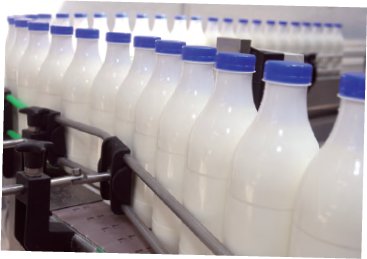
Leonid Shcheglov
A cow drinks cow’s milk when it’s a baby. A bunny drinks bunny’s milk when it’s a baby. Beyond a certain age, even they know that it’s freaky to suckle. And do you ever see them switch and swap? The only time milk is essential for good health is when we are babies, being breast-fed by human mothers. Human breast milk is nature’s perfect formula for human babies. It’s rich in good fats like DHA for brain development, but it’s relatively low in protein. Cow’s milk contains more than three times as much protein as breast milk. That’s because baby cows need a lot more protein. They grow to between 1,500 and 2,000 pounds. Is that your desired weight? If so, hello reality TV!
While the protein in human milk is designed for human bodies, much of the protein in cow’s milk is difficult for humans to digest. Dr. T. Colin Campbell, professor emeritus of nutritional biochemistry at Cornell University, is a pioneering researcher in the investigation of the diet–cancer link. Put his book The China Study on your must-read list today! It clears up the fallacies of our modern diet and provides a thought-provoking look at what really causes cancer. Here’s the CliffsNotes version: One of the biggest contenders is a diet containing more than 10 percent protein (that’s about 50 grams of protein if you’re consuming 2,000 calories per day). Americans eat way more than that (an average of 17 percent total protein, of which 12 to 13 percent is animal-based!). Dr. Campbell found that the protein that consistently creates and promotes cancer is casein, which makes up 87 percent of the protein in cow’s milk.
His research verifies that the types of protein that don’t promote cancer, even at high levels of intake, are the safe proteins from plants. Dr. Campbell writes, “In fact, dietary protein proved to be so powerful in its effect that they could turn on and turn off cancer growth simply by changing the level consumed.” Did you read that correctly? Turn off cancer cells, go veg! Dr. Campbell estimates that “80 to 90 percent of all cancers, cardiovascular diseases, and other degenerative illness can be prevented, at least until very old age, simply by adopting a plant-based diet.”
Forget spooky, life-threatening diseases, let’s talk about simpler pickles. Ever pass a kidney stone? If you have, then you know that it’s incredibly painful—sorta feels like you’re shitting an elephant through your pee hole! How about Crohn’s disease, a veritable pain and inflammation blow-out sale? Both of these not-so-happy afflictions have been linked to dairy consumption. Allergies, eczema, asthma, arthritis, inflammation, and zits can all be linked to dairy. What about skim milk or nonfat milk? They’re just as bad. For me, cheese was the hardest thing to give up, but once I did, my weird rashes and forehead bumps disappeared. I also started to breathe easier—a pretty important change for a gal with cancer in her lungs. Perhaps this is too much information, but my poo changed, too. It came out regularly and stopped being coated in mucus. (More on that in chapter 5, lucky you!)
How about tummy pain and intestinal gas and bloating? Well, there may be a good reason for your belly’s aching. According to the American Academy of Family Physicians, around 75 percent of the world’s adults can’t digest milk (they’re lactose-intolerant). Among some populations, such as Native Americans and Asians, the figure is close to 100 percent. Beyond childhood, most people stop producing the enzyme lactase, which is needed to digest lactose (the sugar in milk). Yeah, your body thinks you should wean, too. I’ve never met someone who didn’t feel better once they removed dairy from their diet. Sorry folks, but all good things come to an end.
STRONG BONES with
LEAN ON ME:
WEIGHT-BEARING EXERCISE
Your bones don’t thrive on calcium alone. One of the best ways to avoid bone loss and build bone density is to do some heavy lifting. Just twelve to twenty minutes of strength-training, weight-bearing, or resistance exercise three days a week, say researchers at the Bone & Joint Injury Prevention & Rehabilitation Center at the University of Michigan, can increase bone density.
Weight-bearing exercise stimulates bone formation and calcium retention. Walking, weight lifting, jogging, hiking, yoga, aerobics, dancing, and working out on the treadmill, elliptical trainer, or stair-stepper are just a few of the fun games you can give your bones. Pick your favorite(s) and commit consistently. If you’re trying something new, find a pro to guide you so you know the proper form. PS: Swimming and biking don’t count. The water and wheels shield you from one very important thing: gravity.

PLANT FOODS HIGH IN C ALCIUM
| Food | Amount | Protein in grams |
| Almonds, dry-roasted | 1 ounce | 80 |
| Arugula | ½ cup | 16 |
| Black beans | 1 cup | 60 |
| Broccoli, cooked | 1 cup | 42 |
| Cabbage, cooked | ½ cup | 25 |
| Chickpeas | 1 cup | 80 |
| Collard greens, cooked | ½ cup | 113 |
| Cranberry beans | 1 cup | 89 |
| Flaxseeds | 1 ounce | 48 |
| Kale, cooked | ½ cup | 90 |
| Kidney beans | 1 cup | 50 |
| Lentils | 1 cup | 38 |
| Natto | ½ cup | 190 |
| Navy beans | 1 cup | 128 |
| Okra | ½ cup | 50 |
| Peanuts | 1 ounce | 15 |
| Pinto beans | 1 cup | 82 |
| Potato, baked | 1 medium | 20 |
| Quinoa | 1 cup | 102 |
| Spinach, cooked | ½ cup, raw | 30* |
| Sunflower seeds | 1 ounce | 34 |
| Sweet potato, baked | 1 medium | 32 |
| Swiss chard, cooked | ½ cup | 30* |
| Tahini | 1 ounce | 128 |
| Tempeh | 1 cup | 184 |
| Tofu | ½ cup | 130 |
| Turnip greens, cooked | ½ cup | 99 |
* Spinach, chard, beet greens, and rhubarb are not the best sources for calcium, because they contain high amounts of oxalates that bind minerals and make calcium unavailable
For more information, I recommend brendadavisrd.com.
Lilli B. Link, MD, MS, is a boardcertified internist currently practicing as a nutritional counselor in New York City. She specializes in raw foods and integrative nutrition. Visit her at www.llinkmd.com.
HORMONES
I don’t know about you, but I’m a child of the ’70s. Back in my groovy day, girls requested training bras for their newly sprouted titties at around thirteen or fourteen years of age. I’ll never forget my “period party” celebration dinner at the Ming Hoy Chinese restaurant (just me and my parents, ugh). Today kids as young as eight are developing into Pam Anderson–stacked rugby players. Not only is it unnatural, it’s dangerous. Let’s look at some possible reasons.
Steroids are widely—and legally—used in the beef, pork, and poultry industries, because they make the animals grow bigger faster. How about hormones? You betcha! In order to make milk all year round, Bessie the cow gets dosed with hormones so she’ll stay constantly knocked up and lactating—a living milk machine. (Damn, I would be such an uncomfortable wench!)
She’s also injected with recombinant bovine growth hormone (rBGH) to double her milk production. This synthetic cocktail increases another hormone, IGF-1, which, as you learned in chapter 3, is linked to the big C. Because she’s a baby factory, a cow makes way more estrogen than nature intended—and it comes out in her milk. In the United States dairy products account for 60 to 80 percent of estrogens consumed!

In 2008 Harvard researchers studied the effect of giving US commercial milk to third-graders in Mongolia. After drinking it for a month, their growth hormone levels shot up 40 percent. The children actually grew about 1 centimeter during the month, a significant statistical change, according to the researchers. Those bright Harvard minds are currently studying whether growth spurts from milk will affect sexual maturity and puberty age. What do you think?
According to researchers at the US Centers for Disease Control and Prevention, in Westernized societies, girls who get their periods before the age of twelve and who have the most menstrual cycles over a lifetime have a higher risk of dying from ovarian cancer than women with fewer period cycles. The same seems to be true of breast cancer. Earlier puberty means more menstrual cycles—and hormone-laced milk, meat, and poultry are associated with bringing on the acne years at a younger age. Childhood obesity also triggers puberty sooner—and kids who consume dairy products and meat tend to be overweight. You can see the way industrial protein production can lead to a disease spiral that starts in childhood.
When I follow the trail, it sure seems like conventional dairy products are more harmful than helpful. My fear is that by the time science has it figured out, we’ll have lost too many of our mothers, sisters, and wives. If you’re only willing to give up one thing, put dairy at the top of the list. Ya think the boys are off the hook? Not so fast, Frankie. Excess estrogen not only makes boys mature later and have man-boobs, but it can also delay emotional development … let the dating disasters begin! And if they make it into the backseat, not to worry: Estrogen is being examined as a possible culprit in declining sperm counts.
Okay, one more hormone rant and I swear I’m done. Got rage? Speaking from experience, I know what it’s like when stress hormones like adrenaline and cortisol explode through my body. I have plenty of work to do controlling my fear and white-hot temper tantrums. I don’t need any additional stress, thank you very much! When cows are being forced into kill chutes at the slaughterhouse, you better believe they know what’s about to happen. The absolute panic forces their bodies to release tons of fight-or-flight hormones, which flood their tissues. When you eat their meat, you’re getting those hormones as well. Not good. I call it chemical karma.
C IS FOR CARCINOGENIC
Let’s move on to something far more uplifting: carcinogens! Cooked meat increases the risk of developing … what else? You guessed it, cancer! Gold star. Even the National Cancer Institute and the American Institute for Cancer Research (AICR) verify that little gem. It’s because cooking meat, especially at high temperatures like on the barbecue grill, under the broiler, or in the deep fryer, creates nasty substances called heterocyclic amines (HCAs). The more well done the meat, the more HCAs it has, and the more carcinogenic it becomes. HCAs are known to cause stomach cancer and also breast, colon, and pancreatic cancer.
THE SKINNY ON ATKINS with
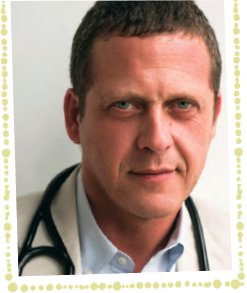
Alejandro Junger, MD, is the best-selling author of Clean: The Revolutionary Program to Restore the Body’s Natural Ability to Heal Itself.
P IS FOR PROCESSED
Processed meats are the worst offenders against our bods. You can and should really do without them. The fare typically served at ballparks, Mafia meetings, and in your cozy breakfast nook I call “L&A meats” because they’re made of lips and assholes—all the leftover stuff too gross for other uses. I’m talking about bologna, pastrami, and salami, as well as hot dogs and sausages, to which carcinogenic nitrates and other chemicals have been added.
This isn’t breaking news to most people. I certainly didn’t think it was a hot topic until I mentioned this information during a speech I gave at a well-respected children’s hospital. After my speech, I was asked to sit on a panel. A lovely young girl raised her hand. She had brain cancer and was concerned about recent findings on the connection between cell phones and tumors. The doctor sitting to my left answered her question very snootily, “Please, there’s no connection. Use your cell phone … and eat your hot dogs, too, for that matter.” I received the doctor’s message loud and clear, as well as her dirty look (which I wanted to smack off her face, but my mother raised a lady!). One week later I received a copy of Good Medicine, the quarterly magazine of the Physicians Committee for Responsible Medicine (PCRM). Check out the title of the lead article in the issue: “Expelled! Processed Meats Cause Cancer. So Why Do Schools Feed Them to Children?” I only wish I was armed with that issue at the podium that day.
That a doctor in a major metropolitan hospital could be so out of touch was astounding. The evidence is overwhelming, and even heavy hitters like the American Cancer Institute and the World Cancer Research Fund agree that no amount of processed meat is healthy; it therefore should be avoided completely. In fact, the risk of colorectal cancer increases by 21 percent for every 50 grams of processed meat consumed daily. Keep in mind that 50 grams is about one hot dog. Other studies have also linked processed meats to cancer of the esophagus, lung, stomach, and prostate. Yet these products are still widely consumed. According to the National Hot Dog & Sausage Council, more than 740 million hot dog packages were sold in 2007. A truckload of which is chowed down each year at the Coney Island hot-dog-eating contest. Boy, is that a gold-star event—the Super Bowl of Gratuitous Gluttony. “Look, world, I ate sixty-eight hot dogs in ten minutes! And as a reward, I get this handsome trophy and a colostomy bag. Gee whiz, dreams really do come true.”
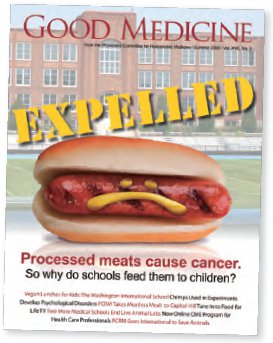
THE REAL COST OF MEAT
Wow—99-cent burgers at the drive-through! A bucket of chicken for pocket change! What a deal! Or is it? From the fast-food window to the supermarket deli counter, the true price of meat in America is actually much higher than what we pay at the register. That’s because behind every pound of flesh sold there is a cascade of hidden costs to our health, economy, and environment.
It takes enormous amounts of resources to raise beef cattle in our factory farm system. To fatten them rapidly, the critters are fed huge amounts of growth hormones and cheap corn. But there’s one problem: Nature designed them to eat grass. Understandably, their modified diet causes all sorts of health problems, which require antibiotics and other drugs. Their health suffers further from often filthy and overcrowded living conditions, meaning more and more antibiotics. A cow can be so unhealthy by slaughter time, it probably would have died of disease soon after anyway.
Government policies play a big role in keeping meat cheap. Subsidies—your tax dollars—pay farmers to grown way more feed corn than is needed, which results in mountains of rotting food and unrealistically low prices. Some even say that the sharp rise in meat consumption we’ve seen over the past few decades was actually caused by all that extra corn looking for a customer!
Subsidies are also filtered through land-use policy. Ranchers who lease public land reap the profits, but we taxpayers pick up the tab for environmental damage. And last but not least, governments love to give tax breaks to anyone promising to bring jobs to town. But the jobs aren’t so great. According to MarketWatch, slaughterhouse workers are among the top ten most underpaid in the US. Unfortunately, they also suffer some of the highest injury rates.
Ever wonder why there are so many recalls of meat because of E. coli or salmonella contamination? The industrial meat system is ground zero for foodborne illnesses. Yum, bacteria on a bun! According to the Centers for Disease Control and Prevention, 76 million Americans are sickened from foodborne illnesses each year. Animal feces are a primary cause, either in meats directly or by contact with the crops grown near the animals. That was the case with the big spinach outbreak a few years ago. The investigation found the likely cause was wild boars that rooted in the cattle lots, then wandered down-valley to poop on the spinach. Of course, the cattle folks did everything they could to blame the spinach.
Massive slaughterhouses, which can kill thousands of Beings per day, are a germ invasion. Bessie is disemboweled and often, in the assembly-line rush, her guts get punctured and fecal matter seeps onto her flesh. This is particularly dangerous with hamburger because when the meat is ground, the pathogens get mixed and spread. Besides that, there’s no such thing as one cow on your plate. Lord only knows how many creatures from how many factories went into that happy meal—it’s kinda like an E. coli smoothie. It takes only a tiny number of bacteria to cause serious illness. And guess who gets it the worst? Old people and kids.
It’s no secret that America is in the midst of a health care crisis, as rising costs threaten to bankrupt our entire economy. And as you’ve already learned, we also have an obesity epidemic. These distinct problems are actually two sides of the same coin, and you can’t fix one without addressing the other. The CDC estimates that the health care price tag of obesity in 2008 was $147 billion—more than doubling in less than a decade. Meat is public enemy number one in heart disease, strokes, and many cancers. And cornfed meat is much higher in saturated fat than meat from cows that graze on grass, their natural food.
The health effects of chemicals and toxins are harder to estimate, but the cost in dollars and lives is certainly enormous. The industrial food system dumps millions of tons of pollutants into our environment every year. Feedlots and farms are responsible for much of it: hormones, medicines, infected fecal waste, fertilizers, and pesticides all end up in our soil and waterways. Ever hear of a dead zone? It’s an area of water that is effectively dead of marine life. Nada, kaput. It’s caused when fertilizers flow downriver from farms and choke out oxygen. There’s a dead zone in the Gulf of Mexico the size of New Jersey and at least 400 others around the world.
In 2006 the United Nations released a report called “Livestock’s Long Shadow.” It revealed that animal agriculture is responsible for more greenhouse gas emissions each year than all the planes, trains, boats, cars, and trucks on earth. Meat production was believed to account for some 18 percent of the world’s total emissions. But scientists have since been revising that estimate upward. In 2009 the World Bank put out a new report that pegged it at 51 percent—more than all other sources combined!
Methane gas from animal poo and farts is a big problem. Methane is twenty-one times more harmful to the atmosphere than CO2. Also contributing to global warming is the bulldozing and burning of rain forest to make way for animal agriculture. In Brazil and elsewhere, lush forests are giving way to barren landscapes for either grazing cattle or growing crops to feed the cattle. Trees act as “carbon sinks” because they inhale and store carbon dioxide. When rain forest is killed, it stops breathing and atmospheric CO2 levels rise. This is also true of our oceans, the other great carbon sink. Coral reefs are like underwater rain forests, teeming with biodiversity. They, too, are endangered as more and more of them die in acidic dead zones.
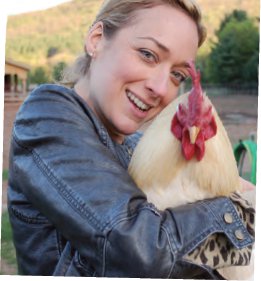
In 2008 Dr. Rajendra Pachauri, the chair of the prestigious United Nations Intergovernmental Panel on Climate Change (IPCC), made waves when he said that reducing meat consumption was the most immediate way to take action against global warming. He suggested we “Give up meat for one day [per week] initially and decrease it from there.” In 2010 the UN further upped the ante by urging a global move towards a meat- and dairy-free diet: “A vegan diet is vital to save the world from hunger, fuel poverty, and the worst impacts of climate change.” Let’s face it, ladies—one day a week without meat? You can do it with your eyes closed. How about three days a week, or five, or seven?
It’s understandable why quality food is condemned as elitist, and why many people, especially the poor, buy cheap food. But now you can see how the 99-cent burger doesn’t really cost 99 cents. There’s always more to a story than meets the eye, and it’s especially true with our way of eating.
A DAY IN THE LIFE of a FACTORY FARM with

Michelle Riley/The HSUS
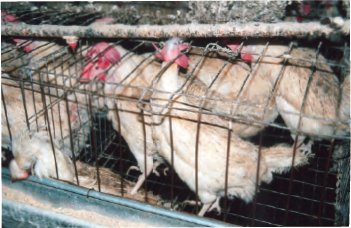
Overcrowded chickens
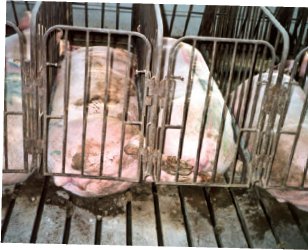
Pigs in gestation crates
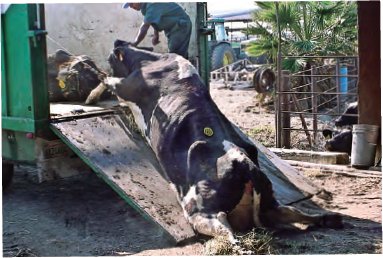
Downer cows on the their way to slaughter
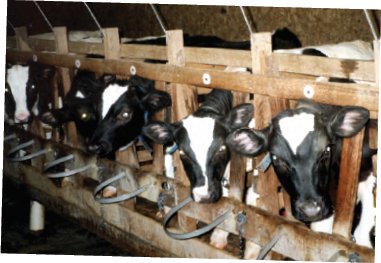
Veal calves
Wayne Pacelle is president and CEO of the Humane Society of the United States. He is cofounder and former chairman of Humane USA, a nonpartisan organization that works to elect humaneminded candidates to political office.
Photos courtesy of Farm Sanctuary and the Humane Society
MAKE THE CONNECTION
Ninety-nine percent of the animal products we consume come from factory farms. I know it’s hard to look at these horrors. Paul McCartney once said, “If slaughterhouses had glass walls, everyone would be a vegetarian.”
Today some farmers are following more sustainable methods of raising beef cattle, poultry and other Beings. They treat their animals more humanely (though they still end up at the same slaughterhouses). Their meat is very expensive, easily three times or more costly than industrial raised flesh. Small farms, like the one I grew up next to, don’t receive government subsidies. You’re paying for healthy livestock without the dangerous shortcuts and drugs.
If after all you’ve learned, you still want to include some meat and dairy in your diet, research a local organic producer. Keep in mind that just because the label says “free range,” “organic,” “natural,” or “grass-fed” doesn’t mean the animals were treated well. If suffering matters to you, limit the amount of nonindustrial animals you eat or buy meat with the Certified Humane Raised and Handled food label. It’s the only program in the United States dedicated to improving the welfare of farm animals from birth through slaughter.
Perhaps you’re still having a hard time with these issues. You may even be angry or agitated at the suggestion to consider animal welfare when preparing your dinner. The compassion lightbulb really turned on for me when I thought about our dog Lola (the best rescue pooch ever!). She has a Christmas stocking. Lola knows more words than some of the kids I taught at NYU. Pigs are no less intelligent, emotional, or social creatures. Calves are sensitive and playful. Chickens love to gossip with their friends. And all mothers love their babies. Let’s take feminism to the next level and stand beside all our sisters, including those with fur and feathers. If we could make the connection between our pets and our plates, we’d respect these Beings more. At the very least, we would demand better conditions for them, and we would grant them a swift and painless death.

Lola, rescued a day before scheduled euthanization
The aforementioned Meatless Monday campaign, in association with the Johns Hopkins School of Public Health, provides lots of recipes, nutritional guidelines, and cooking tips on the Web site www.meatlessmonday.com. Just remember the Crazy Sexy pH nuggets you learned in chapter 2 and stack your plate with more alkaline chow.
My brilliant friend Kathy Freston has this advice for folks who can’t bear to live without certain meaty pleasures: “If you just can’t give up one particular animal product, that’s okay. Give up all of the other ones instead. A friend told me that he loves burgers too much to give them up; I suggested that he give up all animal products except burgers. Some of my friends can’t give up ice cream or cream in their coffee or whatever—so give up everything but that. That’s a huge step forward, and I suspect that after eating mostly vegetarian for a while, you’ll decide that those burgers or that ice cream aren’t so tasty anymore.”
SOY AS A MEAT PROTEIN SUBSTITUTE
There are lots of meat stand–ins on the market today, many of which are made from beans, grains, and veggies, and especially soy. However, you’ll notice that when I talk about soy consumption, I generally accompany my recommendations with the words in moderation. Studies in Asian communities show that the health benefits of soy come from condiment-size portions of fermented soy foods. While soy is high in protein (in fact, it’s a complete protein), tastes yummy, and is less expensive than meat, most of the soy we eat is processed, genetically modified, heavily sprayed, and supersized. As much as possible, eat soy in its natural form.
Choice one: Soybeans and edamame. If you consume tofu, keep it to small amounts and buy organic brands (you can even find sprouted varieties).
Choice two: Fermented soy—tempeh, natto, and miso. Fermented foods have a probiotic effect and are the easiest forms for your body to digest and absorb. The fermentation process also helps to neutralize the high levels of phytic acids (which may block the absorption of minerals like calcium, magnesium, zinc, and iron). See chapter 8 for more info about fabulous fermented goodies.
Because there’s lots of disagreement among doctors and researchers about whether soy is God or the devil, I’m not going to claim to have the answers. Some researchers believe that soy foods increase bone density and even stave off hot flashes. They claim that the isoflavones found in soy can help prevent breast cancer or keep it from recurring. But if you already have breast cancer, particularly if it’s the estrogen-sensitive kind, those same isoflavones could promote the growth of the disease. Ditto for uterine and ovarian cancer, which are also estrogen-sensitive. And for you guys, there’s some evidence that the hormonal effects of soy can promote prostate cancer. Isoflavones can also create potential thyroid complications and mess with endocrine function.
Soy is definitely the ball in a game of contradictory-research Ping-Pong. But here’s what I know for sure: The more processed the soy product, the worse it is for you. I’m talking about faux meats, treats, and snacks. Processed soy is acidic and mucus-forming. Though it’s a helpful transition food as you move toward a vegetarian or vegan diet, don’t overdo it. Also, stick with organic brands.
DON’T HAVE A COW!
Wow—I know this chapter was a biggie. As you feel better, look better, and smile brighter, you will naturally continue to lean toward a healthier way of eating. You’ll want more greens and less flesh. Remember, one of the principles of the Crazy Sexy Diet is balancing the pH of your body. If occasionally eating small amounts of non-factory-farmed animal products keeps you on track, fine. But the more you eat, the more inflamed and acidic you will become. And the money you save by not buying meat can be put toward organic vegetables, a class that excites you, or a relaxing beach vacation!
 testimonial: Maria M.
testimonial: Maria M.
At twenty years old I was running for a division one university. I began experiencing some unusual pain in both of my legs. Three years later, when I could no longer stand up for more than a few minutes, I was diagnosed with Reflex Sympathetic Dystrophy. At that point the pain had spread from both feet to almost every inch of my body and I was staring a wheelchair in the face. In my desperation for the pain to end, I signed up for an experimental five-day inpatient IV ketamine infusion. A day before I headed into NYC to have this experimental procedure done, I went to Best Buy to find a neat documentary to watch in the hospital. I came across Crazy Sexy Cancer, and my whole life changed! Obviously, the procedure did not work, and it was awful! When I was discharged, my parents bought me a juicer, and I have never looked back. I took matters into my own hands and changed my diet, incorporated meditation, prayer, and other spiritual practices including yoga. A year after my diagnosis, I am healthier than I have ever been, even with this disease. With this lifestyle as a supplement to my pain medications, I have avoided a wheelchair and received a 4.0 GPA in my first year of graduate school (for social work). I am by far beating the odds. Thank you, Kris!!!!
CHAPTER  IN REVIEW
IN REVIEW
REMEMBER:
 You can get all the protein and calcium you need from a varied plant-based diet.
You can get all the protein and calcium you need from a varied plant-based diet.
 That same plant-based diet is the best prevention against heart disease, cancer, and diabetes.
That same plant-based diet is the best prevention against heart disease, cancer, and diabetes.
 Dairy causes mucus buildup and has been linked to a variety of illnesses, from asthma to arthritis to Crohn’s disease.
Dairy causes mucus buildup and has been linked to a variety of illnesses, from asthma to arthritis to Crohn’s disease.
 Processed meats are big-time no-nos: salt, fat, body parts, and carcinogens.
Processed meats are big-time no-nos: salt, fat, body parts, and carcinogens.
 Behind every pound of meat sold lies a cascade of hidden costs to our health, economy, and environment.
Behind every pound of meat sold lies a cascade of hidden costs to our health, economy, and environment.
 Try weaning yourself off animal products. Start slow (cut them out one day per week), then build up to more days.
Try weaning yourself off animal products. Start slow (cut them out one day per week), then build up to more days.